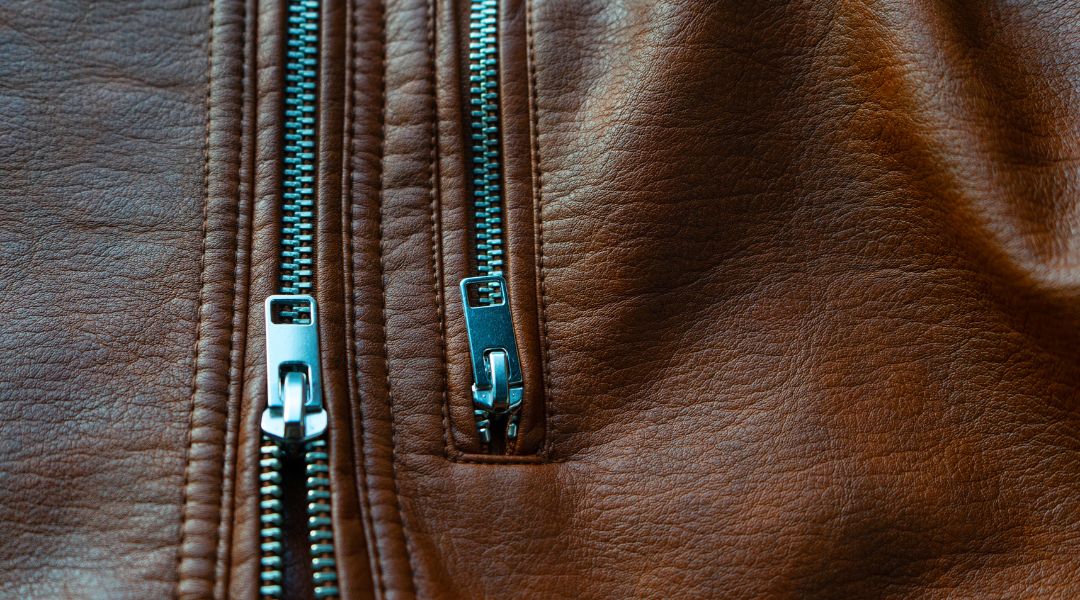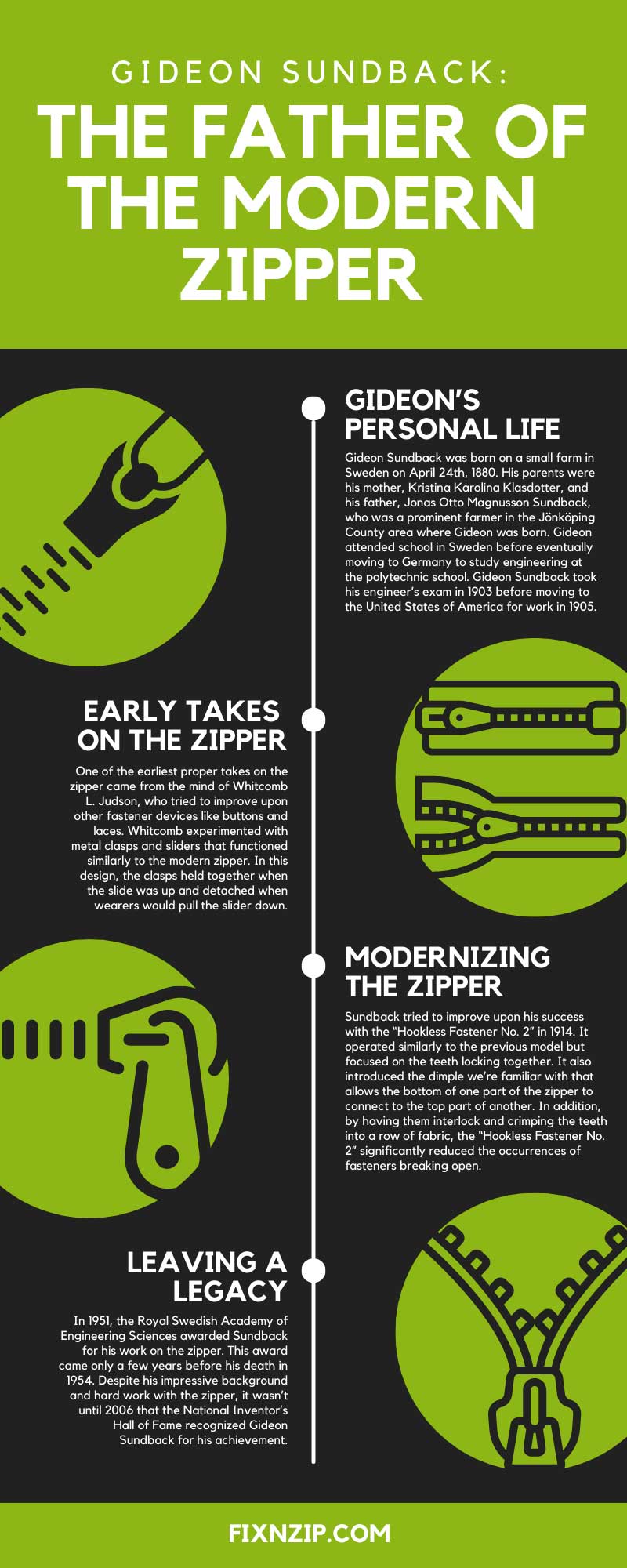
Whether on a backpack, purse, or an article of clothing, zippers are what we use to fasten things together. Most of us probably don’t think about how the zipper has grown or evolved since the earliest iterations. However, the invention and production of the zipper have a rich and fascinating history that links back to a man named Gideon Sundback: the father of the modern zipper.
Gideon Sundback was born on a small farm in Sweden on April 24th, 1880. His parents were his mother, Kristina Karolina Klasdotter, and his father, Jonas Otto Magnusson Sundback, who was a prominent farmer in the Jönköping County area where Gideon was born. Gideon attended school in Sweden before eventually moving to Germany to study engineering at the polytechnic school. Gideon Sundback took his engineer’s exam in 1903 before moving to the United States of America for work in 1905.
Gideon lived in Pittsburgh, Pennsylvania, and got a job working at the Westinghouse Electric and Manufacturing Company. Westinghouse was once the biggest electrical infrastructure in the United States and employed other renowned names like Nikola Tesla and Bertha Lamme. However, Sundback only worked at Westinghouse for a year before moving to Hoboken, New Jersey, and gaining employment at the Universal Fastener Company in 1906. Sundback eventually married Elvira Aronson, the daughter of the plant manager, in 1909, a few years after he’d begun work on his new zipper design.
While we often refer to Gideon Sundback as the father of the modern zipper, the keyword to take from that is “modern.” It’s impossible to overstate Gideon’s work, but nearly everything he brought to the world came from early ideas, sketches, and designs from other engineers.
One of the earliest proper takes on the zipper came from the mind of Whitcomb L. Judson, who tried to improve upon other fastener devices like buttons and laces. Whitcomb experimented with metal clasps and sliders that functioned similarly to the modern zipper. In this design, the clasps held together when the slide was up and detached when wearers would pull the slider down.
One of the largest problems with the older Judson design, which had the working name of the “Judson C-curity Fastener,” was that the metal clasps rarely held together. Pressure from the inside of work boots or bags would cause the clasps to pop open, regardless of the slider’s position. Gideon Sundback wanted to try working with this design and improving upon it.
Earlier versions of Sundback’s attempts resulted in similar failures. The clasps would continuously burst open, and the metal fasteners proved less effective than other options. However, Sundback believed there was potential with this design and finally cracked the code in 1913.
The general idea was simple. If the metal fasteners kept bursting open, they needed to be held more tightly together. Ideas for Sundback’s “Hookless Fastener No. 1” increased the number of metal clasps alongside the fastener from four per inch to roughly 10. The two separate rows of teeth would pull together and lock more together from the slider, pulling them in a given direction. Sundback’s hookless fastener was the first iteration of the zipper that closely resembled the modern form.
Sundback tried to improve upon his success with the “Hookless Fastener No. 2” in 1914. It operated similarly to the previous model but focused on the teeth locking together. It also introduced the dimple we’re familiar with that allows the bottom of one part of the zipper to connect to the top part of another. In addition, by having them interlock and crimping the teeth into a row of fabric, the “Hookless Fastener No. 2” significantly reduced the occurrences of fasteners breaking open.
This design would eventually be the one that Sundback would sketch and use to apply for an official patent. Sunback submitted sketches to the patent office for his “Separable Fastener” on August 24th, 1914. The sketches showcased a Y-shaped slider and detailed drawings to showcase how the teeth could lock the fasteners in place. Patent clerks carefully analyzed the sketches and toyed with Sundback’s design until the separable fastener received official US patent 1,219,881 on March 20th, 1917.
Apart from creating the fastener and patenting it, Sundback put his engineering skills to work and created a machine to manufacture a long continuous chain of zipper teeth. This chain could be cut to any length and given a fastener. Shortly after beginning production, Sundback’s machine was making hundreds of feet worth of zipper per day.
While Sundback improved upon early designs and notes to patent, create, and manufacture what we now know as the zipper, the name itself came from a completely different source. US industrialist B.F. Goodrich pitched the name “zipper” after seeing how the fasteners worked on the boots that his plant was producing. The story goes that “zip” was a pleasant onomatopoeic sound effect from the slider moving up and down. This was a much catchier and snappier name than Sundback’s “separable fastener.”
In the early days, people mainly used zippers for boots and small pouches. Then, in the 1940s, they caught on in the fashion industry and became a widely accepted fastener option for dresses, slacks, jackets, and other garments.
In 1951, the Royal Swedish Academy of Engineering Sciences awarded Sundback for his work on the zipper. This award came only a few years before his death in 1954. Despite his impressive background and hard work with the zipper, it wasn’t until 2006 that the National Inventor’s Hall of Fame recognized Gideon Sundback for his achievement. To this day, Gideon’s quest to improve upon existing metal clasp designs with a focus on engineering and manufacturing enriches our lives and provides us with endless convenience.
If you’d like to learn more about zippers or read helpful guides on zipper repair, FixnZip is here for you. We have several useful blogs and are your one-stop shop for replacement zipper parts and sliders in several shapes and styles. Please browse through our catalog or contact us anytime with additional questions, comments, or concerns, and a member of our team will get you on the right track.

